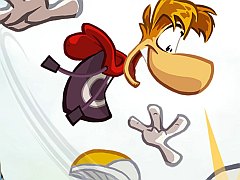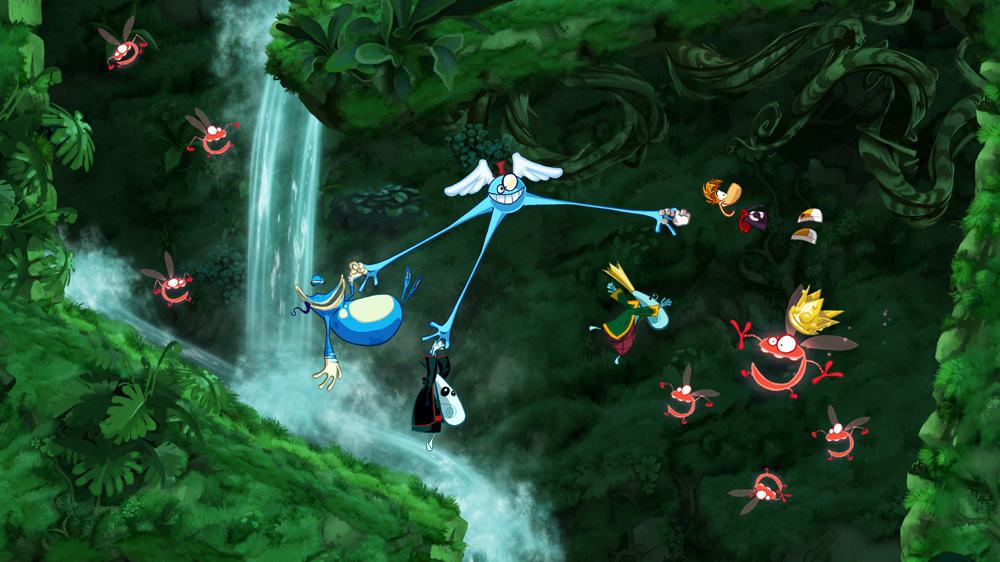You can trust VideoGamer. Our team of gaming experts spend hours testing and reviewing the latest games, to ensure you're reading the most comprehensive guide possible. Rest assured, all imagery and advice is unique and original. Check out how we test and review games here
This review was originally published for the Xbox 360 and PlayStation 3 versions of Rayman Origins back in November 2011. The PS Vita version is a very faithful port of the home console game, with the bright colours and gorgeous animations coming to life on the handheld’s screen.
Sadly the Vita game doesn’t include the cooperative gameplay found in the console versions, instead offering a time-attack mode for certain levels, in which you compete against ghost characters. There’s also the option to share your best times with friends using Near, letting them compete against you. Less useful, but a nice way to get a better view of the colourful graphics, is a pinch zoom system, as used in most modern smart phones.
Somewhere out there, in a leafy private estate, there’s a place called The Bubsy the Bobcat Memorial Retirement Home. This is where all the mascots went at the end of the ’90s. Step inside, and you’ll find a crowd of familiar faces: Aero the Acro-Bat sits in the corner, muttering to himself. Croc and Bug labour over a jigsaw, though it’s missing 13 pieces. Gex the gecko just stands at the window, day after day. The one-liners dried up a long time ago.
Crash Bandicoot is let out on day release, sometimes. He still looks the same, but when you look in his eyes you can tell he’s not really there.
Somehow, Rayman escaped the dusty fate of his contemporaries. Over the past few years he’s been reduced from leading man to a supporting role, playing second fiddle to the Rabbids and their endless mini-games. Now, however, Ubisoft has rewarded Rayman for his patience, returning him to the limelight in a 2D platform outing that immediately recalls the golden days of the genre. It’s the most earnest jump-and-gather exercise since last year’s Donkey Kong Country Returns, and with the emphasis on strict timing, hidden rooms, and the gathering of endless collectibles, it feels as if Nintendo’s unruly ape – and his Rare outings, in particular – has been a major source of inspiration.
But before these old school values kick in – the going gets tough surprisingly quickly – it’s the game’s presentation that will clamour for your attention. Michel Ancel’s characters are beautifully drawn and animated, with playful quirks rewarding even the simplest of player actions: duck while playing as clumpy old Globox, for example, and your body will scrunch up like a concertina, eyes hanging in the air for a fraction of a second and then racing down into place.
The game’s audio design is equally stellar, with each world receiving its own musical theme. Your leaps and bounces (and miserable deaths) are accompanied by playful tunes that flirt with funk, swing, and even do-wop numbers, with layers of sound arriving and departing in response to the challenge you’re currently facing. Jump through a string of collectables and each individual pick-up will trigger a separate note, adding a further melodic snippet to the mix. It’s jaunty, charming stuff – although the persistent use of ukulele does begin to grate after a while.
It’s clear from the look and sound of Rayman Origins that this has been a real labour of love for Ubisoft Montpelier, and thankfully a similar level of care has been afforded to the game’s level design. The five primary worlds (more follow later) gradually introduce fresh mechanics and powers to toy with; initially you’ll be limited to basic dashes, slides, and melee attacks, but with progress you’ll gain access to wall-runs, shrinking abilities, and Rayman’s almost-iconic hover, among other skills. These are all tricks that we’ve seen a hundred times before, but it’s to the game’s credit that the action feels consistently fresh. You’ll regularly run into chase sequences and interludes that mimic scrolling shooters, but even within the standard platform levels there’s a clear commitment to diversity.
Classical references abound at every turn. Midway through an ice-level you’ll suddenly encounter a recreation of the original Donkey Kong, with robotic monkeys lobbing bouncing projectiles down a series of slanted ramps. Later there’s a sequence where you have to forge a path by bashing your way through destructible blocks, digging beneath giant tins that threaten to crush you at any moment; older gamers will immediately identify this as a nod to Boulder Dash.
Even when the game is adopting core staples of the genre, the level design does its best to give things a fresh slant. So, while there are both slippy-slidey ice stages and piping hot lava levels, at one point you’ll find one style segue into the other. Origins’ underwater segments, often the most hated routine in a platformer’s repertoire, are arguably the visual highlight: rather than forcing us to search for life-preserving air bubbles, one stage shrouds you in darkness and then tasks you with swimming towards sources of light – pockets of luminous plankton, or the headlamp of a toothy Anglerfish.
As varied as the action may be, one thing remains constant throughout the game: it’s hard as nails. True, it’s easy enough to sail through the early levels if you’re only trying to reach the exit, but it’s another matter if you’re aiming to complete things properly. Your primary goal is to find the imprisoned Electoons – pink Ribena-berry creatures who provide the key to unlocking new worlds. There’s always one cage at the end of a level, but there are usually another two hidden elsewhere, requiring you to probe the boundaries of your environment. On top of that, additional Electoons are awarded at the close of each stage, depending on how successful you’ve been at gathering the hundred yellow Lums that are scattered throughout.
It doesn’t end there, either – because yet more Electoons can be won for speed-running a level. It all adds up to a nightmare for OCD sufferers, and by halfway through the game you’ll find it all but impossible to grab half the ‘toons available, let alone all of them.
Mind you, by this stage you’ll probably be struggling just to keep your head above water. The game grants you an infinite supply of lives, but as Rayman and his chums die after a single hit – two, if you’ve grabbed the right power-up – mistakes are usually met with instant death, followed by a thankfully swift reload. There’s support for up to three other allies to join you, and while proceedings naturally get a lot more hectic with each additional participant, this does make things a lot easier – not least because dead players return to the fray as floating bubbles, in much the same style as New Super Mario Bros Wii.
In co-op play, many hands make light work. The gathering of Electoons becomes a less arduous process, and many of the more elusive pick-ups are easier to reach when there’s a chum to use as a helpful stepping stone. It’s annoying, then, that there’s nothing in the way of online play. Unless you can rope in a local friend to join you, you’ll be left to face Origins’ challenges alone. It’s a surprising omission on Ubisoft’s part, all things considered, because co-op play is the only real way to mitigate the austere level of challenge.
There’s nothing wrong with a platformer being tough, but where the likes of Super Meat Boy wear their sadistic hearts upon their sleeves, Origins’ unforgiving personality occasionally feels at odds with its cheerful appearance. At the risk of being a stuck record, the level design is consistently strong, but occasionally you’ll wish that the game could ease off a little. It’s rare that the challenge becomes outright infuriating – although there’s a set of chase-based levels that come perilously close – but there are still fleeting moments where it borders on being hard work, rather than fun.
And for all the care and affection that have been poured into Rayman and his buddies, I find them curiously hard to love. It feels cruel to say that, given that Michel Ancel clearly adores Rayman, but it’s true: he’s a bit of an oddity. Given that this is supposed to be an origins story, the plot is initially confusing and then all but invisible – but this matters less than the fact that the otherwise impeccable art style falls down when it comes to tying everything together. Taken individually, there’s not a single character or enemy in the game that hasn’t been sketched with the utmost care, but as an ensemble the cast are strangely lacking in unity.
There’s probably a hardcore cadre of Rayman fans who’ll be left spitting feathers after that last paragraph; if you’re one of these people, you’ll worship this game, and will likely appreciate the dozens of unlockable characters – most of whom look exactly the same to my untrained eye. But even for the rest of us, Rayman Origins has an awful lot to give: it’s a passionate tribute to the days when platform games ruled the Earth, but beyond that, it’s also one of the best examples of the genre we’ve had in recent memory.
Rayman Origins
- Platform(s): iOS, macOS, Nintendo 3DS, PC, PlayStation 3, PS Vita, Wii, Xbox 360, Xbox One
- Genre(s): Action, Arcade, Family, Platformer

/https://oimg.videogamer.com/images/f961/rayman_origins_6-99175.jpg)






